Pros
Cons
Introduction
Front
{{section_header}}{{section.name}}{{/section_header}}

Back
{{section_header}}{{section.name}}{{/section_header}}

Sides
{{section_header}}{{section.name}}{{/section_header}}

Top
{{section_header}}{{section.name}}{{/section_header}}

Bottom
{{section_header}}{{section.name}}{{/section_header}}

In the Box
{{section_header}}{{section.name}}{{/section_header}}

- The camera itself
- Wrist strap
- NB-6L 1000 mAh battery
- CB-2LY battery charger
- USB cable
- A/V out cable (composite video)
- User guide
- Digital camera solution disk (version 54.0)
- Warranty card
Color
{{section_header}}{{section.name}}{{/section_header}}
We found that the S90 captured very accurate color. In this test, we photograph a color chart under tightly controlled conditions, and we found that the S90 captured these colors very well. The only issues we found were that some blues and yellows were a little inaccurate, as you can see from the examples below. However, these shifts were relatively minor. More on how we test color.
The S90 offers a range of color modes (Canon refers to them by the moniker 'My Color'), but we found that the S90 produced the most accurate colors with these disabled. You can see examples of all of the color modes in our Controls section.
Color Modes
{{section_header}}{{section.name}}{{/section_header}}
The S90 includes a wide range of color modes, although most of them seem to be more for novelty use than anything practical. Canon refers to these as My Colors, and the options include vivid, neutral, sepia, black & white, positive, lighter skin, darker skin, vivid blue, vivid green, vivid red and a custom mode. The latter mode allows you to set your own levels for saturation, contrast, sharpness, red, green, blue and skin tone. You can see examples of all of these color modes in the Controls section of this review.
Noise
{{section_header}}{{section.name}}{{/section_header}}
We also found that the S90 did not have a big problem with noise: we found that the noise in our test images were pretty minimal across the ISO range. The noise remains at relatively low levels up to ISO 800, but it does climb significantly above that. However, it remains lower than many comparable cameras at the higher levels, although the images do take on a slightly soft look, as if they were shot through a soft focus filter. The noise reduction that the S90 is applying at the higher levels also means that edges become slightly blurry. More on how we test noise.
In our first test, we shoot our test chart at two light levels: about 3000 lux (rather like a bright sunny day) and at 60 lux (about the same as indoor lighting). In both, the pattern of the noise is the same, although there is more noise in the 60 lux shots. This is because of the longer shutter speeds that these lighting conditions require: the longer the shutter speed, the more noise will be in the images. But the pattern of noise is the same, as you can see on the examples below.
If we compare the noise levels of the S90 with other cameras, you can see that the S90 did well, with noise that is lower than most, especially at the higher ISO levels.
{{comparison_bars title="Noise Score Comparison", attribute="Noise Score", xLabel="Noise Score"}}
ISO
{{section_header}}{{section.name}}{{/section_header}}
The ISO sensitivity range of the S90 starts at 80 and goes up to 3200. In addition, a low light mode that is available on the mode dial extends this range to 12800, but at the cost of reduced resolution of just 1824 by 1368 pixels. Below are examples of photos taken at all of the ISO levels. You can look at the full frame image of any example by clicking on it.
NOTE: The images above are not used in our testing or scoring, but are included here to show real-world examples of the differences between cameras at the various ISO settings.
Resolution
{{section_header}}{{section.name}}{{/section_header}}
our test for the resolution of the images that the S90 captured, we found that it did an excellent job overall. Images were extremely sharp, and low distortion and only slight chromatic aberration. It is important to note here that we are testing the sharpness of the images, not the native resolution that the camera captures at. More on how we test resolution.
Distortion ({{product.raw_scores['Distortion Score']}})
The S90 has a 5x zoom lens, and we found that this only adds a very small amount of distortion to the images it captures. At the wide and middle points of the zoom range, we did notice some slight distortion; around 1.3 per cent of barrel distortion at both ends. What this means is that straight edges (such as walls or lampposts) may look slightly bowed outwards at both ends of the zoom range. The distortion at the telephoto end of the zoom range was less than half a per cent, which is barely noticeable.
Sharpness ({{product.raw_scores['Sharpness Score']}})
We were extremely impressed with the sharpness of the images that the S90 shot; they were consistently sharp both across the frame and across the zoom range. There were a few minor issues, though; the edges of the frame at the zoom settings were slightly softer than the middle, particularly those on the left side of the image. However, even these edges were not a huge problem; fine details were still captured in the image, but without the razor-sharp clarity of the middle.You can see examples from our test images in the crops below.
Chromatic Aberration ({{product.raw_scores['Chromatic Aberration Score']}})
Chromatic Aberration occurs because the elements of the lens deflect colors of light differently; it usually shows up as a slight colored fringe to high contrast edges, such as the edges of the blocks in our color chart. We saw some evidence of this from the S90, particularly at the wider zoom settings. However, the amount of aberration that we saw was low, even at the wider zoom settings.
Quality & Size Options
{{section_header}}{{section.name}}{{/section_header}}
The S90 has a wide range of image size and quality settings, ranging from the maximum 10 megapixel images down to 0.3 megapixel images. In addition, there are two quality settings: fine and standard. The S90 is also unusual amongst point & shoots in being able to capture RAW images, which contain the raw data from the image sensor. The S90 can also capture a RAW and JPEG image simultaneously, giving the convenience of a JPEG and the quality of the RAW at once.
Image Stabilization
{{section_header}}{{section.name}}{{/section_header}}
The S90 includes an optical stabilization system that moves an element of the lens in response to camera shake, but we found that this was only moderately effective. We test this on point & shoot cameras by attaching the camera to our stabilization system, setting the camera to shoot at 1/30 of a second and taking photos with stabilization on and off. For the S90, we found that the images with stabilization on were slightly sharper than with stabilization off, but only by a very small amount. More on how we test image stabilization.
Video Mode
{{section_header}}{{section.name}}{{/section_header}}
The S90 shoots movies at a maximum resolution of 640 by 480 pixels, which is standard definition. Other cameras can record high definition video, but the S90 is limited to standard definition. The files are recorded as MOV files which use H.264 compression, with mono sound captured from the microphone under the small hole next to the lens. While shooting, you cannot use the optical zoom, but a 4x digital zoom is available. You can, however, use the optical zoom prior to shooting then use the digital zoom while shooting, for a total possible zoom of 15x.The image quality does deteriorate when using the digital zoom, though.
Video Color
{{section_header}}{{section.name}}{{/section_header}}
Although we were impressed with the color of the still images that the S90 captured, we were not overly impressed with the color of videos; the color were slightly inaccurate and the video was very highly saturated, leading to artificially bright and garish colors. More on how we test video color.
{{comparison_bars title="Video Color Score Comparison", attribute="Video Color Score", xLabel="Video Color Score"}}
Video Sharpness
{{section_header}}{{section.name}}{{/section_header}}
We were also less than impressed with the sharpness of the video; the video had a soft, blurry look, especially with moving objects. This is partly down to the low resolution that the camera captures video at (640 by 480 pixels; significantly less than the 1920 by 1080 that many capture at), but the video is also very heavily compressed, which leads to lost detail. More on how we test video sharpness.
{{comparison_bars title="Video Color Sharpness Comparison", attribute="Video Sharpness Score", xLabel="Video Sharpness Score"}}
Playback Mode
{{section_header}}{{section.name}}{{/section_header}}
Pressing the playback button on the S90 puts it into playback mode. In this mode, you can look at photos in a number of ways, including viewing up to 36 thumbnails on screen once and zooming in up to 10x. You can also view a number of different levels of information on the images, ranging from none to pretty much every control and a histogram of the image density.
In-Camera Editing
{{section_header}}{{section.name}}{{/section_header}}
Basic editing features are on offer from the main menu of the S90; images can be cropped, resized and have red-eye removed. You can also apply all of the color effects that are described in the Controls section after an image is taken. Also offered is Canon's own i-Contrast processing, which does a decent job of correcting for under or over exposure of images.
Direct Print Options
{{section_header}}{{section.name}}{{/section_header}}
The standard features for printing photos are included. Photos can be tagged for printing by pressing the short cut button on the back of the camera, which flags the image for printing using the DPOF image format. The S90 can also be connected directly to any printer that supports the common PictBridge standard, where the camera connects to the printer over a USB cable, so you can print photos without using a computer.
Viewfinder
{{section_header}}{{section.name}}{{/section_header}}
There is no viewfinder on the S90; images are previewed through the LCD screen.
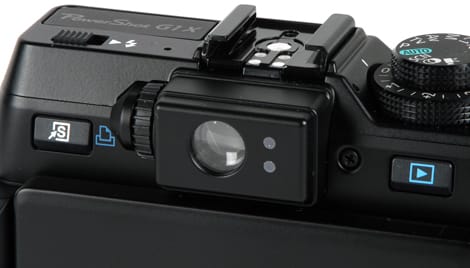

... and it has a diopter adjustment ring.
Display
{{section_header}}{{section.name}}{{/section_header}}
The 3.1-inch screen on the back of the S90's body is a big, bright screen that has around 460k pixels. We found that the screen was clear and sharp, providing a good preview of the images that the camera captures.

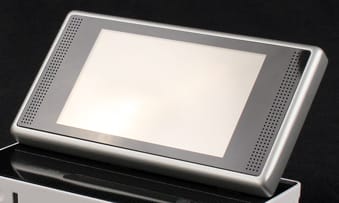
...but it turns into a nice 3-inch widescreen in playback mode.
Flash
{{section_header}}{{section.name}}{{/section_header}}
The S90 includes a small pop-up flash that jumps out of the top left corner of the camera case when required. When it is not used, it fits back into the camera body completely. We found that this flash had rather limited range; it could only illuminate objects out to about 5 to 7 feet.

The flash emitter pops up from the top of the body via a mechanical release.
Lens
{{section_header}}{{section.name}}{{/section_header}}
The lens of the S90 is made by Canon themselves and has a focal length of 6 to 22.5mm, which is equivalent to a 28 to 105mm zoom on a 35mm camera. That's a 3.8x zoom length, which is a little shorter than the 10 and 12x zooms that we see on some point and shot cameras. However, 3.8x is enough for most uses; as you can see from the examples below, it is long enough to capture everything from a group shot to a head and shoulders shot from a distance.

Battery
{{section_header}}{{section.name}}{{/section_header}}
The S90 gets juiced up by a small Li-ion battery that fits into the cavity on the bottom of the camera body. This NB-6L battery is charged up in an external charger: there is no way to charge it within the camera body itself. Canon claims a battery life of about 220 shots with the LCD on, which would tie in with our informal testing: we were able to shoot for several days without charging. A spare battery will cost you $60.

Memory
{{section_header}}{{section.name}}{{/section_header}}
The S90 uses SDHC memory cards to store photos, although it is also compatible with the older SD card type. An 8GB SDHC card will cost you about $25, and can hold about 3,000 images at the highest resolution and quality, which should be enough for most trips. There is some internal memory on the camera, but this cannot be used to store photos.

Jacks, Ports & Plugs
{{section_header}}{{section.name}}{{/section_header}}
There are just two ports on the S90; a mini HDMI port for connecting to a HDTV, and a combination USB and A/V out port that connects to a computer or an analog TV. Kudos to Canon for making this port compatible with standard USB cables; if you lose the included USB cable, you can use one from another device with a standard USB type A plug on the end.
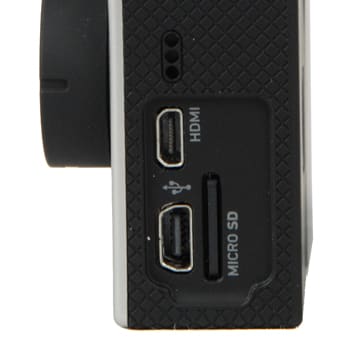
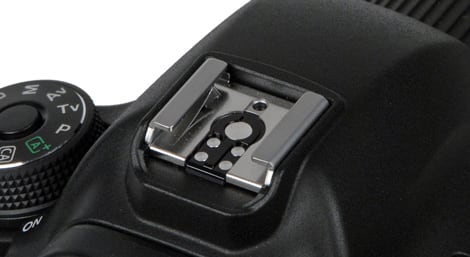
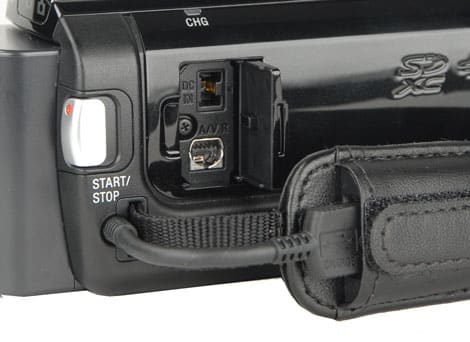
The DC-input and multi-AV port are located on the right side of the camcorder.
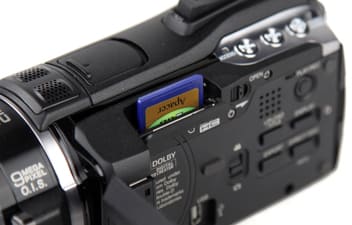
... as is the SD/SDHC card slot.
Shooting Modes
{{section_header}}{{section.name}}{{/section_header}}
The S90 has a lot of shooting modes on offer. On the mode dial there are options for a full auto mode, a program mode, shutter and aperture priority mode, a full auto mode and a custom mode that uses a set of customized saved settings. In addition , there are sports for a low light and movie mode, as well as a scene mode setting. If this is selected, you can choose one of 18 scene modes, which include the usual suspects (portrait, landscape) plus a few unusual modes (aquarium, underwater and two modes that help create panoramas.
Auto Mode Features
Focus - The S90 uses a single focus point in the center of the frame. You do get the option to change the size of the frame, but you can't move it off-center. There is also an option to use face detection to focus in on faces. We did find that the auto focus worked quickly, though; it usually snapped into place and beeped reassuringly in less than a second.
Macro focus down to a minimum distance of 2 inches is also offered, as well as a manual focus mode.We found this is relatively easy to use, as you can use the control dial on the back of the camera or the control ring on the front to focus.
The S90 is unusual in offering focus bracketing. When enabled, this will take 3 images with different focus points when you press the shutter, which could be useful if you don't trust the single focus point to get it right.
Exposure - The S90 did good job of correctly guessing the correct exposure in our tests, but there are also several options to tweak this if required. You get exposure compensation of 2 stops up or down, and the camera can also automatically take 3 bracketed exposures at up to 2 stops up and down. This is good to see on a point & shoot camera: many don't offer any form of bracketing.
Metering - The usual options of a full evaluative mode, center weighted and spot metering are offered on the S90. In addition, a face detection mode finds and meters for faces in the frame.
Self-Timer - The S90 offers a lot of options in its self timer feature. As well as the usual simple 10 and 2 second delays, the camera can take a number of photos (from 3 to 10) when it detects a face in the frame. There is also a custom option which allows you to set the delay (up to 30 seconds) and the number of shots that are taken (from 3 to 10). The one thing that is missing is an interval timer, where the camera takes a number of shots at a preset time interval.

The full mode dial is nice, but frequently rotates by accident.
Scene Modes
Changing modes is very easy: for most you just twist the mode dial. Changing scene modes is a bit more awkward; you have to scroll through the list using the control dial on the back of the camera. This can take some time, and there is no way to quickly skip through the list.
Picture Effects
{{section_header}}{{section.name}}{{/section_header}}
The S90 includes a number of modes designed to produce a specific look in the image in the My Colors menu. Examples of the options on offer are below.
Manual Controls
{{section_header}}{{section.name}}{{/section_header}}
The S90 offers a full auto mode for white balance, as well as 7 presets and an evaluative mode. In this, you point the camera at something white and press the shutter, and it judges the white balance. Unusually, you can also tweak any of the presets for more precise control.
The full manual mode gives you plenty of control over the aperture of the S90, and there is a decent aperture range. At the widest setting, the aperture range is from f/2.0 to f/8, which is unusually wide. At the telephoto end, the range is a little more restricted: f/ 4.9 to f/8.0.
In most modes, the shutter speed range of the S90 is from 1 second down to 1/1600 of a second. In the shutter priority and full manual modes, this is expanded to 15 seconds to 1/1600 of a second. 1/1600 of a second is fast enough for most uses, but it might not be fast enough to freeze some fast moving objects, such as a speeding tennis ball or an overly candied small child.
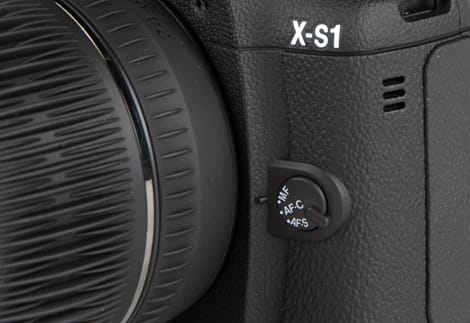
A dedicated focus-mode switch on the front panel.
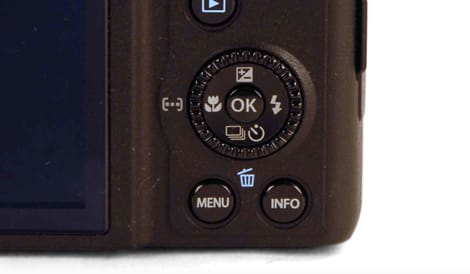
The scroll wheel surrounding the d-pad is neither awful nor perfect.
Drive/Burst Mode
{{section_header}}{{section.name}}{{/section_header}}
Two burst modes are available on the S90: continuous shooting and continuous shooting AF. In the latter mode, the camera continuously keeps checking the focus point and adjusting it if required.
Shot to Shot ({{product.raw_scores['Shot to Shot Score']}})
Shooting in the continuous mode, we found that the S90 managed to capture a touch over 1 frame a second (1.04 a second, to be exact). That's on the slow side; many other point & shoot cameras can manage many more, or offer special modes that capture a lot of images quickly. The S90 does not.
Handling
{{section_header}}{{section.name}}{{/section_header}}
The S90 is a small camera, but it fits well into the hand. There is no raised ridge on the front, but there is a small ridge below the mode dial on the back that gives the thumb something to grip onto. This allows for a reasonably tight grip, but we'd recommend the use of the wrist strap if you are a rollercoaster fan. Most users will probably default to a two-handed hold when taking photos, but it works well in one or two hands.


Two hands are also needed to use the control dial on the front of the camera, around the lens.


These dedicated buttons give you quick access to aperture and shutter speed controls.
Buttons & Dials
{{section_header}}{{section.name}}{{/section_header}}
The S90 includes an unusual number of buttons and dials for a point & shoot, with the really unusual one being the control ring on the front around the lens. This makes it feel a little like an SLR or an old-school film camera; you twist the ring around to change the selected feature. By default, this ring is used to control the ISO setting, but it can also be set to control exposure compensation, manual focus, white balance or the zoom setting in program mode. In the manual mode, the exposure compensation option changes to shutter speed. This is extremely useful, as it means you can go fully manual but still control shutter speed quickly with the front control ring and aperture with the back control dial. Most point & shoots with a manual mode force you to use a combination of keys to switch from shutter to aperture control.

The other controls are on the top and back of the camera. On the top is the power button , the ring function, the shutter and the mode dial. On the back is a shortcut control, playback, the 4-way control and control dial and a display and menu button. The shortcut button can be set to a number of functions, including enabling face detection, exposure and focus lock or changing the metering mode.

Menus
{{section_header}}{{section.name}}{{/section_header}}
The S90 has two separate menus: the function menu for the basic functions, and the main menu for everything else. The function menu is accessed by pressing the func. button in the middle of the directional control pad, and offers options for things such as white balance, color mode, bracketing, etc.
The main menu contains all the other features. It is divided into three tabs: shooting settings, camera settings, and the customizable my menu settings. The shooting settings tab is for features such as enabling/disabling the digital zoom, setting the AF mode, etc. The camera settings menu is for features such as formatting the memory card, the power saving settings and others. The My Menus tab allows you to create a customized menu that contains commonly used features for quick access.
Manual & Learning
{{section_header}}{{section.name}}{{/section_header}}
Accompanying the S90 is a 179 page manual that covers a lot of ground, from basic functions like turning the camera on to manually tweaking the white balance settings. It does so well, with clear, accurate explanations in plain language.
Canon PowerShot SD970 IS Comparison
In terms of the specs of the two products, the Panasonic ZS3 is the top pick: it has a longer zoom (12x against the 3.8x of the Canon) and shoots HD video. But a camera is about more than specs, and the competition between the two is much closer in terms of how they perform. We found that the Canon was the superior performer in terms of the noise and resolution; the images it captured had lower noise and more detail. The Panasonic had slightly better color performance, though, and their image stabilization system was superior to the Canon, producing sharper shots at our tested shutter speed of 1/30 of a second.
The Canon S90 was the easier camera to use; the combination of the front control wheel and the control dial on the back of the camera made it much quicker to switch modes and change settings like the shutter speed, and the dial around the lens has an undeniable retro charm.
One area where the Panasonic clearly excels is in shooting movies: it records video at a much higher resolution with better detail, color and smoother movement. So if you are looking for a combination still and video device, the Panasonic is the best choice. But if you focus more on still images, the two cameras are very evenly matched.
Fujifilm FinePix F200EXR Comparison
Canon's own SD970 IS is cheaper than the S90 (about $320 against the $430 of the S90) and shoots higher resolution images (12.1 megapixels against 10 megapixels). But more megapixels do not a better camera make; the two cameras were very evenly matched in our resolution tests. And we also found that the S90 had less noise in images than the SD970, which is another consequence of higher resolutions. But we did find that the video that the SD970 captured was better than the S90; the SD970 had better color and more detail in the video it captures. That's partly because it captures video at a higher resolution in 720p format, with a resolution of 1280 by 720 pixels.
COMP 3
The Fuji D200EXR uses some fancy new technology to try and improve performance, but we didn't see a huge performance boost from this. The Fuji did score higher than the S90 in some areas, though; both resolution and color were slightly better. But Fuji's claim of superior low light performance was not borne out; we found that the S90 produced images were lower levels of noise without the fancy sensor features of the Fuji.
The Canon S90 was also the easier camera to use, with the front control ring making it easier to control features such as the zoom and ISO level. On the Fuji, these features have to be accessed through the on-screen menu.
Conclusion
The Canon PowerShot S90 is rather expensive for a point & shoot camera at $430. But it has the performance to justify it, with the camera achieving excellent scores across most of our tests. Most point & shoot cameras do well in one test but poorly on others, but the S90 was good across pretty much all of them, with accurate color, low noise at most ISO settings and sharp, clear images with plenty of detail.
The control ring on the front of the camera is also a big plus, adding another way to take control of the picture taking process. This is one of only a handful of point & shoot cameras that allows you to easily control both shutter and aperture settings in the manual mode. With most point & shoot cameras, you have to set shutter speed and then aperture, but the S90 puts shutter speed on the front control ring and aperture on the back control dial, so you can set both quickly.
The things we didn't like about this camera were few, but the main one was the poor video mode. In an age of point & shoots that record high definition video, the blurry, grainy 640 by 480 pixel video that the S90 shoots feels positively primitive. This would be a big problem for the user who wants a do it all device; they would be better off with a camera that shoots better video such as the Panasonic ZS3. And the S90 will be overkill for for those who just want to take snapshots, but it is an excellent pick for the photographer who wants a compact but controllable camera that shoots great photos.
Photo Gallery
{{photo_gallery "Front Photo", "Back Photo", "Sides Photo", "Top Photo", "Bottom Photo", "Lens Photo", "Flash Photo", "EVF Photo 1", "EVF Photo 2", "LCD Photo 1", "LCD Photo 2", "Media Photo", "Modes Photo", "Manual Controls Photo", "Manual Controls Photo 2", "Other Controls", "Buttons 1", "Buttons 2", "Other Hardware Photo", "Battery Photo", "Ports Photo 1", "Ports Photo 2", "Ports Photo 3", "Ports Photo 4", "Handling Photo 1", "Handling Photo 2", "Handling Photo 3", "Box Photo"}}
Meet the tester
Richard Baguley is a veteran writer who has written about technology ranging from Alphabet to Zip file utilities. He has contributed to pretty much every major tech publication, including Amiga Format Magazine, PC World, Wired, CNET, Toms Guide, Forbes, and many others. He lives in the Boston metro area with his wife, dog, and an indeterminate number of cats.
Checking our work.
Our team is here to help you buy the best stuff and love what you own. Our writers, editors, and experts obsess over the products we cover to make sure you're confident and satisfied. Have a different opinion about something we recommend? Email us and we'll compare notes.
Shoot us an email